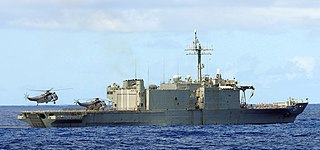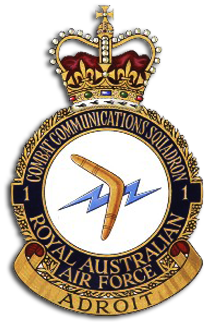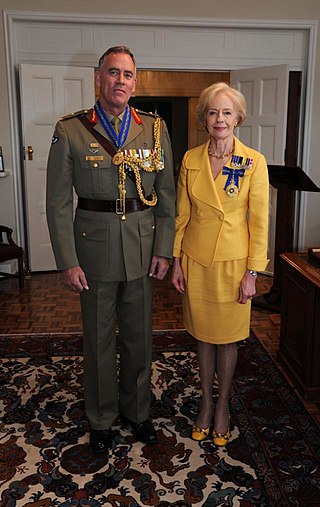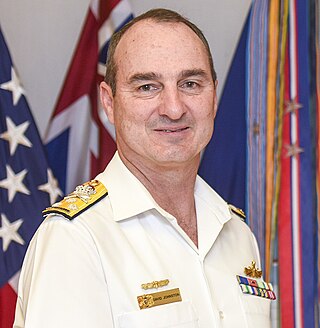
Australia joined a U.S.-led coalition in the Iraq War. Declassified documents reveal that the decision to go to war was taken primarily with a view to enhancing its alliance with the United States.

The Australian contribution to the war in Afghanistan has been known as Operation Slipper (2001–2014) and Operation Highroad (2015–2021).

HMAS Kanimbla was a Kanimbla-class landing platform amphibious ship operated by the Royal Australian Navy (RAN). Originally built for the United States Navy (USN) as the Newport-class tank landing shipUSS Saginaw (LST-1188), the ship was decommissioned in 1994 and sold to the RAN.

The Australian Active Service Medal (AASM) is an Australian military decoration. It was authorised on 13 September 1988 to recognise prescribed service in "warlike" operations, backdated to February 1975. It is awarded with a clasp to denote the prescribed operation and subsequent awards of the medal are made in the form of additional clasps. In 2012, it was announced that the medal would no longer be issued for future operations, with the AASM and the Australian Service Medal being replaced by the Australian Operational Service Medal.

The Royal Australian Air Force's No. 1 Combat Communications Squadron (1CCS) is a squadron within No. 95 Wing and is responsible for the provision of expeditionary Communications and Information Systems (CIS) to support Air Force and Australian Defence Force operations and exercises.

1st Battalion, Royal Australian Regiment is a regular motorised infantry battalion of the Australian Army. 1 RAR was first formed as the 65th Australian Infantry Battalion of the 34th Brigade (Australia) on Balikpapan in 1945 and since then has been deployed on active service during the Korean War, the Malayan Emergency, the Vietnam War, Unified Task Force in Somalia, East Timor, Iraq War and Afghanistan. Additionally, the battalion has deployed on peacekeeping and other operations to a number of countries including Japan, Rifle Company Butterworth, Timor Leste, Solomon Islands, Tonga and the Philippines. 1 RAR remains one of the Australian Army's most readily deployed units sending individuals and detachments to domestic, regional and other enduring operations. The battalion is currently based in Coral Lines at Lavarack Barracks, Townsville, Queensland, where it forms part of the 3rd Brigade.
The Distinguished Service Cross (DSC) is a military decoration awarded to personnel of the Australian Defence Force. It is awarded for distinguished command and leadership in action. The DSC was introduced in 1991 and is the highest distinguished service decoration in the Australian Honours System. Recipients of the Distinguished Service Cross are entitled to use the post-nominal letters "DSC". Since its inception 115 awards have been made—which includes eight first bars and one second bar.
The Nursing Service Cross (NSC) is a conspicuous service decoration of the Australian honours and awards system, instituted by Letters Patent on 18 October 1989.
The Unit Citation for Gallantry is a collective group decoration awarded to members of Australian military units. It recognises extraordinary gallantry in action. The Unit Citation for Gallantry was created in 1991, along with the Meritorious Unit Citation. The actual citation is a warrant presented to the unit. Insignia are worn by individuals to denote their membership of a unit that has been awarded a citation. Personnel cannot be issued with the insignia until the authorised unit representative, normally the Commanding Officer, has been formally invested with the citation.

Major General Timothy Joseph McOwan, is a retired senior officer of the Australian Army. He served as Special Operations Commander Australia from February 2008 until January 2011, and the Australian Defence Attaché and Head Australian Defence Staff in Washington, D.C. He retired from the army in 2014.

Air Chief Marshal Mark Donald Binskin, is a former senior officer in the Royal Australian Air Force. He served as Chief of Air Force (2008–11), Vice Chief of the Defence Force (2011–14), and Chief of the Defence Force from June 2014 until his retirement in July 2018. In February 2020 he was appointed as a Commissioner and Chairman of the Royal Commission into National Natural Disaster Arrangements. He is the current chair of the Civil Aviation Safety Authority of Australia.

Mentoring Task Force One (MTF-1) was a combined arms battle group formed by the Australian Army for deployment as part of Operation Slipper during the War in Afghanistan. Formed in 2009 from the 7th Brigade, the unit consisted of infantry, engineers, cavalry, artillery and logistic elements from 55 different units, but was predominately based on the 6th Battalion, Royal Australian Regiment. Based at Forward Operating Base Ripley outside of Tarin Kowt in Uruzgan Province as part of a multinational brigade known as Combined Team Uruzgan, MTF-1 was tasked with counter-insurgency operations in conjunction with United States, Dutch and other coalition forces, operating from a number of patrol bases in the Mirabad, Baluchi and Chora valleys. MTF-1 served in Afghanistan from January to October 2010.
The Queen's Birthday Honours 2013 were announced on 10 June 2013 by the Governor General of Australia, Quentin Bryce.

Vice Admiral Michael Joseph Noonan, is a retired senior officer of the Royal Australian Navy, who served as Chief of Navy from 6 July 2018 to 6 July 2022. He previously served as Commander Border Protection Command from 2013 to 2015 and Deputy Chief of Navy from 2016 to 2018.

Vice Admiral David Lance Johnston, is a senior officer in the Royal Australian Navy. He served as Deputy Commander Joint Task Force 633 on Operation Slipper in 2010, Commander Border Protection Command from 2011 to 2013 and, following promotion to vice admiral, was posted as Chief of Joint Operations from 2014 until 2018. Johnston was appointed Vice Chief of the Defence Force in July 2018.
The Queen's Birthday Honours 2014 were announced on 9 June 2014 by the Governor-General of Australia, Sir Peter Cosgrove.
The Queen's Birthday Honours 2015 for Australia were announced on 8 June 2015 by the Governor-General, Sir Peter Cosgrove.
The 2018 Queen's Birthday Honours for Australia were announced on 11 June 2018 by the Governor-General, Sir Peter Cosgrove.

Vice Admiral Jonathan Dallas Mead, is a senior officer in the Royal Australian Navy. He joined the navy via the Royal Australian Naval College at HMAS Creswell in 1984, and spent his early career with the Clearance Diving Branch before training as a Principal Warfare Officer. He captained HMAS Parramatta on operations in the Persian Gulf from 2006 to 2007 during the Iraq War and commanded Combined Task Force 150, overseeing maritime counter-terrorism operations around the Arabian Peninsula and Horn of Africa, from 2011 to 2012. He served as Head of Navy Capability from 2015 to 2017, Commander Australian Fleet from 2018 to 2020, Chief of Joint Capabilities from 2020 to 2021, and was appointed Chief of the Nuclear-Powered Submarine Task Force in September 2021.
The Special Honours Lists for Australia are announced by the Sovereign and Governor-General at any time.












